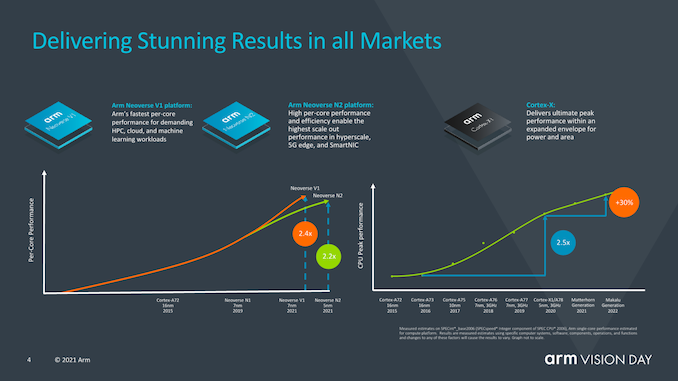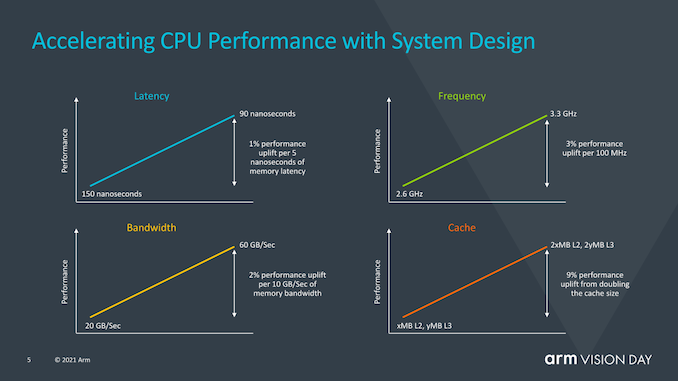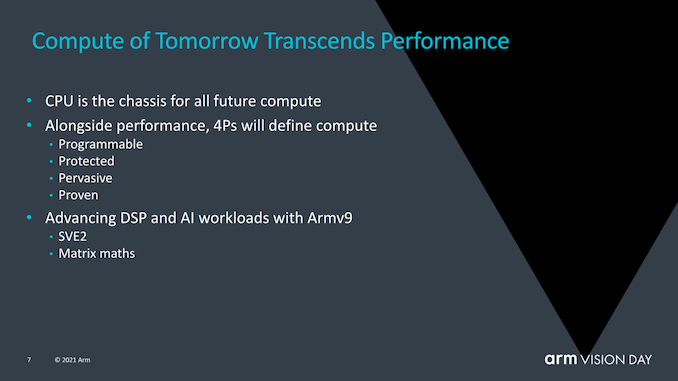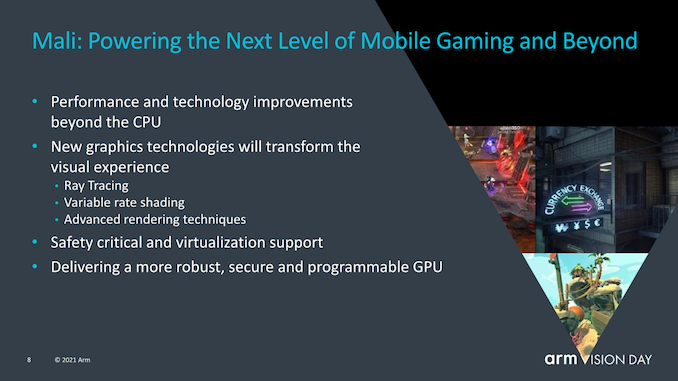Arm Announces Armv9 Architecture: SVE2, Security, and the Next Decade
by Andrei Frumusanu on March 30, 2021 2:00 PM ESTFuture Arm CPU Roadmaps
Not directly related to v9, however tied into the technology roadmap of the upcoming v9 designs in the near future, Arm also talked about some points regarding their projected performance of v9 designs in the next 2 years.
Arm talked about how the mobile space had seen performance increases of 2.4x (we’re talking purely ISO-process design IPC here) of this year’s X1 devices compared to the Cortex-A73 a few years ago in 2016.
Interestingly, Arm also talked about Neoverse V1 designs and how they’re achieving 2.4x the performance of A72 class designs, and discloses that they are expecting the first V1 devices to he released later this year.
For the next-generation mobile IP cores, code-named Matterhorn and Makalu, the company is disclosing an aggregate expected 30% IPC gain across these two generations, excluding frequency or any other additional performance gains which could be reached by SoC designers. This actually represents a 14% generational increases across these two new designs, and as showcased in the performance curve in the slide, would indicate that improvements are slowing down relative to what Arm had managed over the past few years since the A76. Still, the company states that the rate of advancement is still well beyond the industry average – admittedly that is being dragged down by some players.
Oddly enough, Arm also included a slide that wanted to focus on the system-side impact on performance, rather than just CPU IP performance. Some of the figures presented here, such as 1% of performance per 5ns of memory latency have been figures that we had talked about extensively for a few generations now, but Arm here also points out that there’s a whole generation of CPU performance that can be squeezed out if one focuses on improving various other aspects of an implementations by improving the memory path, increasing caches, or optimising frequency capabilities. I consider this to be a veiled shot at the current conservative approaches from SoC vendors which are not fully utilising the expected performance headroom of X1 cores, and subsequently also not reaching the expected performance projections of the new core.
Arm continues to see the CPU as the most versatile compute block for the future. While dedicated accelerators or GPUs will have their place, they have a hard time to address important points such as programmability, protection, pervasiveness (essentially ability to run them on any device), and proven abilities to work correctly. Currently, the compute ecosystem is extremely fragmented in how things are run, not only differing between device types, but also differing between device vendors and operating systems.
SVE2 and Matrix multiplication can vastly simplify the software ecosystem, and allow compute workloads to take a step forward with a more unified approach that will be able to run on any device in the future.
Lastly, Arm had a nugget of new information on the future of Mali GPUs, disclosing that the company is working on new technologies such as VRS and in particular Ray Tracing. The latter point is quite surprising to hear, and signals that the desktop and console ecosystem push by AMD’s and Nvidia’s introduction of RT is also expected to push the mobile GPU ecosystem towards RT.
Armv9 designs to be unveiled soon, devices in early 2022
Today’s announcement came in an extremely high-level format, and we expect Arm to talk more about the various details of Armv9 and new features such as CCA in the company’s usual yearly tech disclosures in the coming months.
In general, Armv9 appears to be a mix between a more fundamental ISA shift, which SVE2 can be seen as, and a general re-baselining for the software ecosystem to aggregate the last decade of v8 extensions, and build the foundation for the next decade of the Arm architecture.
Arm had already talked about the Neoverse V1 and N2 late last year, and I do expect the N2 at least to be eventually unveiled as a v9 design. Arm further discloses to expect more Armv9 CPU designs, likely the mobile-side Cortex-A78 and X1 successors, to be unveiled this year, with the new CPUs likely to have already been taped-in by the usual SoC vendors, and expected to be seen in commercial devices in early 2022.














74 Comments
View All Comments
HardwareDufus - Friday, April 2, 2021 - link
you are a rather offensive and unpleasant person.... why do you repeatedly say things like are you stupid, that sounds stupid, are you on drugs?can you find a nicer way to express your disagreement with what others have posted?
grant3 - Wednesday, March 31, 2021 - link
TSMC is a design-agnostic foundry. They build the highest performing x86 chips available. They will (presumably) continue to build x86 as long as a customer is willing to pay to have them built.I presume you're saying Apple is the 2nd biggest threat to x86 because they are transitioning away from x86 processors in their computers. But apple is transitioning TOWARDS arm architecture. So it's completely nonsensical to say "Apple (the company) is a bigger threat than ARM (an architecture)t" when they are both integral to the same transition.
Furthermore: Apple computers have used x86 architecture for a lot fewer years than they DID use x86 architecture. Apple's transition might by a *symptom* of x86 possibly approaching end-of-life, but it sure is not a CAUSE of it. Until Apple obtains a vast majority of personal & server computing market share, which would be unprecedented, it is not itself a threat to x86 remaining a highly-used computing architecture.
Ppietra - Wednesday, March 31, 2021 - link
Threats don’t come only from companies that can reduce x86 marketshare significantly and directly. Threats also come from companies that can change people/market perception about the need of x86 processors - that is actually the first step needed before the marketshare drops significantly. Apple is one of such companies and Intel has already demonstrated that it is indeed a threat (not a symptom).Kjella - Wednesday, March 31, 2021 - link
Apple might be transitioning but software companies rarely will, they'll go from some old assembler code to a higher level language where ARM/x86 code is a compile away. While I agree that there's been a lot of false starts, the M1 is causing a lot of spring cleaning in desktop-oriented companies who's managed to ignore smartphones/tablets like for example getting Adobe to make a native version of Photoshop. If you're indifferent about ARM or x86, that's a win for ARM.back2future - Thursday, April 1, 2021 - link
Customers who decide to buy that 300 billion devices on ARM v9.x ISA that next decade are final decision about production success. If these customers (generally) stay with x86/x64 this would balance statistics in different manner and on desktops or laptops there is availability for grown, mature programs for technical drawing and design, analysis, devices support, databases access or office related support software still an advantage for to decide. Mobile devices (Android) have wider variety of (useful) apps that fulfill smaller tasks for users (like access to IoT devices, that are probably bigger share of 300 billion devices 'til 2030, been 180 billion ARM SoCs 'til 2021)?No problem having ARM device beside x64 device, because there are cheap available of either ARMv9.x or x86/x64)
melgross - Saturday, April 10, 2021 - link
To Apple, the ARM cores are just a part of their SoC, and possibly not the most important part.SarahKerrigan - Tuesday, March 30, 2021 - link
If "going nowhere" means moving core volume that makes x86 look like small fry, making serious inroads in servers and HPC, and getting the buy-in of the most profitable PC OEM (Apple), sure. What were you expecting, that "ARM succeeding" means "x86 drops to zero in eight years"? "x86 is going to be the downfall of RISC/UNIX" was something that was being said when the 486 was new, and RISC/UNIX was still a majority of server revenue into the 2000s and is still big money (billions of dollars a year today.)Shifts take time, and even if x86 does enter terminal decline - and I'm not necessarily saying it will - desktop PCs will be the last part to go.
name99 - Tuesday, March 30, 2021 - link
Uhh, ARM IS the next big thing TODAY.Last time I checked the mobile market is a lot larger than the PC market...
You're like the guy who insists "microprocessors never won! IBM is still selling mainframes and they still kick ass". It's true. mainframes still sell, and still kick ass. But they don't define the state of computing.
Intel will be around for a long time supporting the "requires x86 market"; that was never in doubt. The point is, x86 no longer defines the interesting state of computing; it's fading away to mainframe status before our eyes.
Oh sure, there'll be a few more glory years -- peak IBM was 1985 -- but the pattern is laid out.
And are you incapable of understanding the article? SVE/2 WILL be available across the industry! That's a large part of the point of creating this new v9 branding and establishing a new baseline for the ARM community.
darkich - Wednesday, March 31, 2021 - link
Exactly.29a - Wednesday, March 31, 2021 - link
"ARM was prophacized in 2013 as the next big thing, and it went nowhere"I guess 99.999999999999% of mobile devices is nowhere?